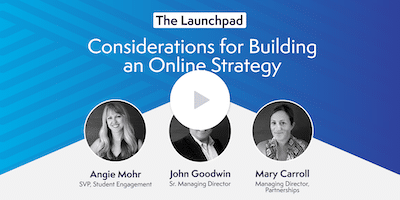Six Proven Ways to Reach Nontraditional Students
The nontraditional student population now makes up the majority of higher education students (74%), according to a recent study from the National Center for Education Statistics (NCES), and this population continues to grow — in both number and importance. Within the undergraduate student population alone, about 37% are aged 25 and older, 24% have dependents, and 64% work while enrolled in college, according to the Lumina Foundation.
The target audience is shifting for higher education marketers, providing a fresh opportunity for you to realign your enrollment strategies. Here are six proven tips that will help your institution’s marketing team better reach and engage nontraditional learners.
1. Embrace Nontraditional Students as the New Normal
To better understand how to embrace the nontraditional student demographic, you need to understand how “nontraditional” has been redefined over the years.
What Is a Nontraditional Student?
The NCES categorizes a nontraditional student as someone who:
- Is financially independent
- Has one or more dependents
- Is a single parent or caregiver
- Works a full-time job while in school
- Attends school part time
- Did not enroll in a higher ed institution within one academic year of graduating from high school
- Received a GED certificate or other high school equivalency diploma instead of a regular high school diploma
Students only have to meet one of these qualifications to be considered nontraditional. However, these criteria tend to be interrelated, so many nontraditional learners check more than one box on this list.
Tailoring Your Strategy to Your Audience
These changing student demographics mean that students’ needs are different from those of the generations before them. Nontraditional learners are baby boomers, millennials, veterans, parents, and career changers. They most likely work part time or full time and have varying levels of prior experience with college. This audience is more diverse than ever before, and without getting to know them at a high level, you won’t be able to reach them and address their individual needs.
2. Understand Key Differences and Motivations of Nontraditional Students
Nontraditional students often differ from more traditional learners in the challenges they face and what motivates them to enroll. You must understand these differences at a macro level to determine the key features, benefits, and outcomes to focus on in your messaging strategy.
Nontraditional students experience numerous barriers to entry into degree programs, including high tuition costs and complex application processes. They often have significant responsibilities in their day-to-day lives and are unable to manage a full-time, in-person course load. Ease of enrollment, scheduling options, and location flexibility are key for these individuals.
These students are motivated to enroll in a program for career-focused reasons such as remaining competitive in their current role, earning a promotion, or overcoming a wage ceiling. But they also may feel overwhelmed by enrollment challenges. Going back to school is a lofty commitment, and your marketing team will need to instill confidence in prospective students at every step of the process, from application to graduation.
3. Dig Deeper to Understand Beyond “Nontraditional” Macro Student Profiles
When talking to nearly three-quarters of the entire student population, you must pay attention to their macro-level needs and to trends, but you also need to take a magnifying glass to the data you’re gathering. You should research and understand the specific demographics of the students in each of your individual programs. In this process, you can uncover the messaging that resonates with those audiences along with the most effective channels to reach them. Developing personas around some of these specific areas is essential before making any and every marketing choice. Base your ad campaigns and creative production around these personas. If you’re not actively building for them, you won’t be building with them.
4. Show Prospective Students How Your Institution Meets Their Needs
To connect with nontraditional students, you must show them how your institution is uniquely suited to meet their individual needs. They’re looking to understand the role a program can play in helping them achieve their goals.
Highlighting your institution’s affordability, accessibility, and student support are great starting points, but higher ed marketers should avoid generic, overused statements. Rather than sharing a general message, home in on your institution’s unique offerings. What exactly will you deliver within these categories? Do you have a generous credit transfer policy or an accelerated program? Are you well known for degree completion, no application fee, night and weekend classes, online options, or rolling start dates?
The more your creative concepts and messaging can speak to these categories in a personal way, the more value you can build in the eyes of your audience. Make it clear what your school offers specifically, and reiterate those offerings in as many instances as possible. The key is to highlight what makes your institution stand out in those categories.
5. Help Prospective Students Connect to Outcomes
“Seventy percent of adult learners say that learning skills and knowledge that will apply to their post-graduation job opportunities is necessary when choosing where to enroll,” according to a study by Public Agenda. Your messaging should communicate what students can accomplish once they complete the program. Use fact-based data surrounding job titles, placement, and salaries. Show them real-life examples with student testimonials about job placement and satisfaction. Qualitative testimonials give prospective students an opportunity to relate and connect. The data helps them justify their decision to apply, while the emotional connection is what will ultimately drive them to act.
If you don’t have video testimonials from students and alumni today, prioritize this project. Hearing genuine satisfaction from actual students can make a big difference. And this content can go anywhere: short social clips, website landing pages, nurturing campaigns, and more. Future students will believe in your program when they hear how it has positively impacted your alumni’s lives.
6. Harness the Power of an Immediate, Personalized Follow-Up
Prospective students have more program choices than ever before, so you need to make a good impression right off the bat. With this audience, you can’t rely on look books and campus tours to drive applications and enrollments. Nontraditional student enrollment has become primarily digital in nature, and this diverse audience utilizes a variety of digital channels.
If you’re relying solely on phone calls and emails to follow up with prospective students, you’re likely missing out on 10% to 20% of additional enrollments from your existing inquiry flow, according to internal data we’ve collected here at Archer Education. Being everywhere your prospects are is a big task, as is being able to engage in a personalized way, at scale. But it can be done. And it is worth the effort. Using a multichannel, personalized outreach strategy can help you engage, empower, and educate prospective students. If you’re interested in learning more, tune in to our recent webinar “One Size Fits One”, where we discuss the benefits of technological support in student enrollment and retention.
Rise to the Challenge
When facing constraints like continuing enrollment declines and the looming enrollment cliff, a higher ed institution’s survival depends on their ability to creatively restructure and rebuild their marketing efforts. Enrollment marketers and admissions teams alike must get to know the nontraditional student and adapt their approach to embrace this new population. To empower them to enroll and succeed, your teams need to get to know them at both the micro and macro levels.If you don’t have the bandwidth to implement these six strategies, or you’re struggling to connect with nontraditional students, we can help. Archer Education partners with dozens of institutions to help them overcome enrollment challenges using tech-enabled, personalized enrollment marketing and management solutions. Click here to request more information about Archer’s full-funnel engagement strategies and digital student experience technology.



